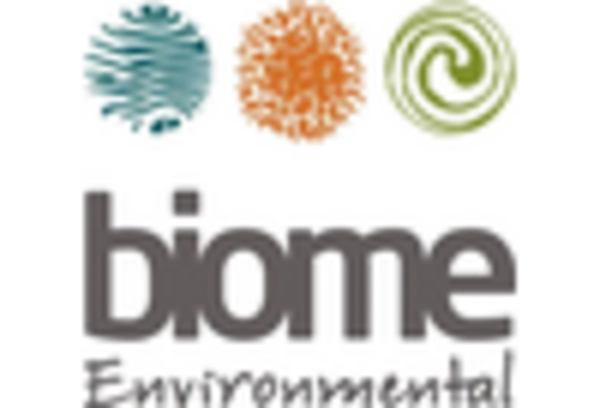Corporate Sustainability Goals
The increasing emphasis on corporate sustainability goals is significantly impacting the Environmental Hazard Monitoring Software Market. Companies are now integrating sustainability into their core business strategies, which includes monitoring and managing environmental risks. This shift is driven by consumer demand for environmentally responsible practices and the need to enhance brand reputation. As a result, organizations are investing in monitoring software to track their environmental performance and report on sustainability metrics. Recent surveys indicate that over 70% of companies are prioritizing sustainability initiatives, which is likely to boost the demand for environmental monitoring solutions. This trend suggests a promising outlook for the market as businesses strive to meet their sustainability objectives.
Government Regulations and Policies
Government regulations and policies play a crucial role in shaping the Environmental Hazard Monitoring Software Market. Many countries are implementing stricter environmental regulations to combat pollution and protect natural resources. These regulations often mandate the use of monitoring software to ensure compliance with environmental standards. For instance, the introduction of the Clean Air Act and similar legislation has led to increased demand for software solutions that can monitor air quality and emissions. The market is expected to grow as organizations invest in compliance technologies to avoid penalties and enhance their environmental performance. It is estimated that the regulatory landscape will continue to evolve, further driving the adoption of environmental hazard monitoring solutions.
Integration of IoT and AI Technologies
The integration of Internet of Things (IoT) and Artificial Intelligence (AI) technologies is transforming the Environmental Hazard Monitoring Software Market. IoT devices facilitate real-time data collection from various environmental sensors, enabling continuous monitoring of hazardous conditions. AI algorithms analyze this data to predict potential hazards and recommend preventive measures. This technological synergy is expected to enhance the accuracy and efficiency of environmental monitoring systems. According to recent estimates, the market for IoT in environmental monitoring is projected to reach USD 5 billion by 2026, indicating a robust growth trajectory. As organizations increasingly adopt these technologies, the demand for sophisticated environmental hazard monitoring solutions is likely to rise, driving the overall market forward.
Rising Awareness of Environmental Issues
There is a growing awareness of environmental issues among the public and businesses, which is significantly influencing the Environmental Hazard Monitoring Software Market. As climate change, pollution, and biodiversity loss become more pressing concerns, organizations are compelled to adopt monitoring solutions to mitigate their environmental impact. This heightened awareness is reflected in the increasing investments in environmental technologies, with a reported increase of 15% in funding for environmental startups in the past year. Companies are now prioritizing sustainability and compliance with environmental regulations, which further propels the demand for effective monitoring software. This trend suggests that the market will continue to expand as stakeholders seek to address environmental challenges proactively.
Technological Advancements in Data Analytics
Technological advancements in data analytics are reshaping the Environmental Hazard Monitoring Software Market. Enhanced data analytics capabilities allow organizations to process vast amounts of environmental data more efficiently, leading to better decision-making and risk management. The emergence of big data technologies and machine learning is enabling more sophisticated analyses of environmental hazards, which can improve predictive capabilities. As organizations seek to leverage data for strategic insights, the demand for advanced monitoring software is expected to increase. Market analysts project that the data analytics segment within environmental monitoring will grow at a compound annual growth rate of 12% over the next five years, indicating a strong trend towards data-driven environmental management.


















Leave a Comment